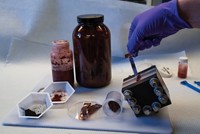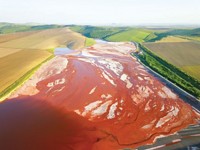Advertisement
Grab your lab coat. Let's get started
Welcome!
Welcome!
Create an account below to get 6 C&EN articles per month, receive newsletters and more - all free.
It seems this is your first time logging in online. Please enter the following information to continue.
As an ACS member you automatically get access to this site. All we need is few more details to create your reading experience.
Not you? Sign in with a different account.
Not you? Sign in with a different account.
ERROR 1
ERROR 1
ERROR 2
ERROR 2
ERROR 2
ERROR 2
ERROR 2
Password and Confirm password must match.
If you have an ACS member number, please enter it here so we can link this account to your membership. (optional)
ERROR 2
ACS values your privacy. By submitting your information, you are gaining access to C&EN and subscribing to our weekly newsletter. We use the information you provide to make your reading experience better, and we will never sell your data to third party members.
Synthesis
Mining waste displays catalytic prowess
Simple process turns toxic red mud from aluminum processing into an active catalyst for generating hydrogen from ammonia
by Mitch Jacoby
September 5, 2016
| A version of this story appeared in
Volume 94, Issue 35
In a laboratory demonstration of the old adage “one man’s trash is another man’s treasure,” researchers in Turkey have shown that red mud, a hazardous by-product of aluminum processing, can be converted simply and inexpensively to a catalyst that liberates hydrogen from ammonia (Sci. Rep. 2016, DOI: 10.1038/srep32279). The finding might lead to a more practical way to safely store and generate enough hydrogen for fuel-cell vehicles to enable long-distance driving between refueling stops. Red mud is the highly alkaline sludge formed by sodium hydroxide digestion of bauxite ore. Known as the Bayer process, this bit of caustic chemistry, which is the main method for extracting aluminum from the ore, globally generates more than 100 million metric tons of the mud per year, which remains rich in iron and other heavy metals. Samira Fatma Kurtoğlu and Alper Uzun of Koç University report that treating the sludge with hydrochloric acid and exposing it to ammonia at 700 °C converts iron in the material to a catalytically active iron nitride species, ɛ-Fe2N. Tests show that the treated mud decomposes NH3 to H2 and N2 nearly as well as costly ruthenium catalysts, which are often used for this application, and better than any other non-precious-metal catalyst.




Join the conversation
Contact the reporter
Submit a Letter to the Editor for publication
Engage with us on Twitter